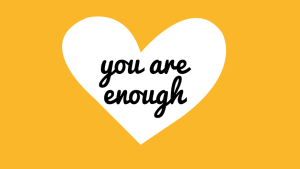
Source: Getty Images
(TRIGGER WARNING: Eating disorders, thinspiration)
The word thinspiration defines itself.
It’s a portmanteau, or linguistic blend, used to describe images created and used to inspire its consumers to be thin.
It usually comes in the form of images of thin women (TW), featuring celebrities or fashion models that are looked up to as standards of beauty, with figures ranging from naturally slim to dangerously emaciated.
But “reverse thinspiration” – pictures of overweight people and greasy, fatty foods (TW) – is also used similarly, as a way to elicit disgust and aversion: “You want to be the former, not the latter,” thinspo blogs scream, echoing in the brains of the disordered, compounding their illness.
Inspirational quotes often accompany these images (TW), proving that the written word is still an effective form of influential media.
“Stay strong,” users urge, creating, sharing, and spreading graphic memes that feature mantras, song lyrics, and literary quotations sometimes twisted to sound supportive of eating disorders. “I know it hurts, but starving works.”
Many pro-eating disorder websites have special message boards dedicated solely to the purpose of creating and sharing this stuff.
It’s a rabbit hole that’s been described as “disturbing” and “grotesque” by some, but it’s also a painfully realistic glimpse into the world of eating disorders.
The problem is: It isn’t confined to the realm of eating disorders anymore. It’s mainstream.
That is: Although thinspiration’s roots can be found in pro-eating disorder websites – communities that hail the illnesses as lifestyle choices, essential to the sufferers’ personal identities, that they believe should be maintained and respected, its branches have started to snag mainstream media.
Traditionally a tactic used in pro-ana and pro-mia communities in order to motivate readers to fast and to propel them deeper into their disorder – a sort of idolization inspiring solidarity – thinspiration is now plastered all over every single social media website in existence.
And we’re not talking to consumers about it.
Because we’ve largely been unaware of who the consumers are.
And although, according to a 2006 Stanford Medical School study, over 35% of people already diagnosed with eating disorders have visited pro-anorexia websites, eating disordered people are not the only ones visiting and being affected by thinspiration.
A 2010 study by Jett, LaPorte, & Wanchisn showed that 84% of non-eating disordered participants decreased their weekly calorie intake by an average of 2,470 calories after viewing pro-eating disorder websites, with only about half of the participants actively perceiving the reduction.
And multiple studies have shown, unsurprisingly, that women and girls who view pro-eating disorder websites are more likely to have negative body image than those who do not (Custers & Van den Bulck, 2009; Wilson, Sperry, & Thompson, 2008).
And maybe that wouldn’t be so horrifying if it wasn’t for the fact that over 12% of 13-17 year old girls and nearly 6% of similarly-aged boys have self-reported visiting pro-anorexia websites at least once (Custers & Van den Bulck, 2009).
And who’s surprised?
You can easily find thinspiration by typing in the right keywords into any social networking site. Hell, when I peruse the tea tag on Tumblr, I run into thinspo. On the regular.
Sites from LiveJournal and MySpace to Facebook and Instagram have been called to action to remove pro-eating disorder content from their spaces.
Many of them have chosen to edit their Terms of Service to cut down on thinspiration by lumping it into the self-harm category, explaining that content that inspires others to harm themselves is inappropriate and dangerous.
And yet, all of these sites have been unsuccessful in stopping the viral spread of triggering material to mainstream audiences.
Thinspiration is taking the already effed-up cultural ideal of size zero and amplifying it, selling fixation resulting in dissatisfaction – to everyone, not just people with eating disorders.
Thinspiration is trickling into mainstream society, beyond pro-eating disorder websites, at the same time that extreme dieting and celebrity critique culture is thriving.
To the untrained eye (or, you know, undeveloped adolescent brain), this just seems like an extension of a culture that has already been engrained into our consciousness. Everybody’s doing it.
But what might come off at first as harmless idolization can quickly turn into harmful obsession – manifesting itself in an infatuation with thigh gaps and hip dips.
And this is bad news.
But how do we talk to our friends, children, and students about it without being at war with them? How do we have a conversation about media literacy when it comes to thinspiration without 1) accusing them, 2) exacerbating the problem, and/or 3) scaring them into hiding?
Where do we start?
Three Ways to Approach the Thinspiration Conversation
#1: Come At It As Curious, Not Concerned
Your goal here is to get a person to open up, not shut down.
Keep in mind that healthy communication isn’t about interrogating. It should be a conversation where all involved parties feel comfortable and can communicate.
One way to do this is to ask questions, rather than provide answers.
Use genuine questions where you’re really trying to get honest answers. If you use leading questions to coax certain answers out of someone, you’re creating a one-sided, manipulative conversation.
To try to avoid making it too personal (and therefore, anxiety-inducing), speak generally rather than specifically. Use phrases like “girls your age” or “teenagers on social media sites” instead of “you.”
In short: Make it known that you’re in-the-know and give people a trusted place to have conversations and seek help. Make it clear that you understand that there’s an issue and that you’re there to talk.
Remember that this is an ongoing dialogue – and make sure that the person you’re concerned about knows that, too.
#2: Avoid Accusatory Vernacular
As soon as you come at someone using words and phrases like “thinspiration” and “eating disorders,” you’ve shut them down to productive conversation.
You don’t want this conversation to be about what they’re doing wrong.
A good way to start this conversation off on the right track is to use “I” statements rather than “you” statements.
Even if you want to outright express your concern for this person’s consumption of thinspiration, you can do it in such a way that you own your feelings, rather than trying to own their experience.
“I saw a special on the news about beauty standards and Tumblr. Do you know anything about that?”
“When I think about what it means to aspire to a certain kind of beauty, I think of _____ and _____. What do you and your friends think?”
“When I was your age, it was really en vogue to have pin-straight hair, and my friends and I would work really hard to achieve that goal, even if it was impossible for our natural bodies. What kinds of things like that are in style today?”
These conversation starters go a lot further than talking at someone about unrealistic beauty standards and how thinspiration fuels eating disorders.
Don’t panic. Just talk.
#3: Stay Body-Positive, But Not Body-Focused
This is something that I try to do always in my life, but especially when trying to talk to someone about thoughts and behaviors around food, fat, and bodies: Avoid drawing attention to their bodies or making comparisons.
“Most girls don’t look like supermodels anyway” or “All of the women in our family have wide hips” aren’t helpful comments to someone who is questioning their self-worth.
Even well-meaning comments that are supposed to be compliments – “I think your body is perfect just the way it is” or “You look good with meat on your bones” – should be avoided.
Exuding a sense that all bodies are good bodies is important. But when you keep the focus on the body, it’s hard to move away from the idea that beauty matters. Shift the conversation.
Because even positive body obsession is still body obsession.
—
Thinspiration can be scary – just like any other form of media that engulfs and brainwashes us out of our sense of reality.
The media is a powerful force, and sometimes, we can feel so, so powerless against it. How do we even begin to battle that fire-breathing dragon?
But you’re not powerless.
And the media doesn’t have to pillage your mind.
Education makes for strong armor. And media literacy is a critical step toward combatting dangerous beauty standards.
You just have to be up for the challenge.
You can change someone’s entire worldview just by starting a conversation.
If that isn’t power, I don’t know what is.
Want to discuss this further? Login to our online forum and start a post! If you’re not already registered as a forum user, please register first here.
Melissa A. Fabello is the Editor at Everyday Feminism. She’s a feminist blogger and vlogger, as well as an online peer sex educator, based out of Philadelphia. Along with Everyday Feminism, Melissa also currently works with Miss Representation and Laci Green’s Sex+ community and hosts a YouTube channel called “Everyday Media Literacy.” She is a second-year graduate student, working on an M.Ed. in Human Sexuality. She can be reached on Twitter @fyeahmfabello and Tumblr. Read her articles here and book her for speaking engagements here.
Search our 3000+ articles!
Read our articles about:
Our online racial justice training
Used by hundreds of universities, non-profits, and businesses.
Click to learn more
Most Read Articles
- « Previous
- 1
- …
- 30
- 31
- 32


















